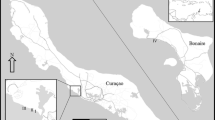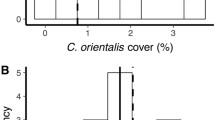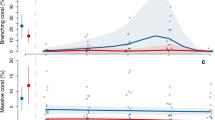Abstract
Few studies have documented the spatial and temporal dynamics of highly invasive species in coral reef benthic communities. Here, we quantified the ecological dynamics of invasion by a corallimorph, Rhodactis howesii, at Palmyra Atoll in the central Pacific. A localized outbreak of this species was first observed following a shipwreck at Palmyra in 1991 and has subsequently spread across hectares, reaching 100% cover in some areas. We examined the spatial and temporal dynamics of this invasion, and its impact on the benthic community, using a combination of permanent photoquadrats and large-scale photomosaic imagery. Our data revealed two distinct patterns in the spatial dynamics of R. howesii on the reef. First, following the removal of the shipwreck in 2013, the cover of the corallimorph in the immediate vicinity of the wreck decreased markedly, with crustose coralline algae (CCA), an important reef-builder, dominating the newly available substrate. However, in contrast to the decline at the epicenter of the invasion, the corallimorph has spread to additional sites around the atoll where increases in abundance have been associated with decreases in hard coral cover. Reductions in percent cover and corallimorph patch size near the epicenter of the outbreak, coupled with increases in cover and patch size and appearance of the corallimorph at other locations around Palmyra, demonstrate the dynamic nature of this “invasion.” Further, we found that the corallimorph settled disproportionately often on patches of turf or CCA cover, but can then overgrow all benthic competitors following establishment. This study provides evidence that R. howesii has the capacity to be highly invasive on coral reefs and highlights the importance of large-scale, long-term monitoring efforts to capture the dynamic nature of such invasions.






Similar content being viewed by others
References
Barott KL, Smith JE, Dinsdale E, Hatay M, Sandin SA, Rohwer RL (2009) Hyperspectral and physiological analyses of coral-algal interactions. PLoS ONE 4(11):e8043
Barott KL, Rohwer FL (2012) Unseen players shape benthic competition on coral reefs. Trends in Microbiology 20(12):621–628
Barott KL, Williams GJ, Vermeij MJA, Harris J, Smith JE, Rohwer FL, Sandin SA (2012) Natural history of coral-algae competition across a gradient of human activity in the Line Islands. Mar Ecol Prog Ser 460:1–12
Birrell CL, McCook LJ, Willis BL, Harrington L (2008) Chemical effects of macroalgae on larval settlement of the broadcast spawning coral Acropora millepora. Mar Ecol Prog Ser 362:129–137
Bosence DWJ (1983) Coralline algal reef frameworks. J Geol Soc London 140:365–376
Boudouresque CF, Meinesz A, Ribera MA, Ballesteros E (1995) Spread of the green alga Caulerpa taxifolia (Caulerpales, Chlorophyta) in the Mediterranean: possible consequences of a major ecological event. Sci Mar(BARC) 59:21–29
Box SJ, Mumby PJ (2007) Effect of macroalgal competition on growth and survival of juvenile Caribbean corals. Mar Ecol Prog Ser 342:139–149
Carter AL (2014) Invasion Mechanisms of the corallimorph, Rhodactis howesii, at Palmyra Atoll. UC San Diego
Chadwick NE, Morrow KM (2011) Competition among sessile organisms on coral reefs. Coral Reefs: an ecosystem in transition. Springer, pp 347–371
Chadwick-Furman NE, Spiegel M (2000) Abundance and clonal replication in the tropical corallimorpharian Rhodactis rhodostoma. Invertebr Biol 119:351–360
Chadwick NE, Adams C (1991) Locomotion, asexual reproduction, and killing of corals by the corallimorpharian Corynactis californica. Hydrobiologia 216–217:263–269
Cheal AJ, MacNeil MA, Cripps E, Emslie MJ, Jonker M, Schaffelke B, Sweatman H (2010) Coral-macroalgal phase shifts or reef resilience: Links with diversity and functional roles of herbivorous fishes on the Great Barrier Reef. Coral Reefs 29:1005–1015
Conklin EJ, Smith JE (2005) Abundance and spread of the invasive red algae, Kappaphycus spp., in Kane’ohe Bay, Hawai’I and an experimental assessment of management options. Biol Inva 7:1029–1039
Côté IM, Gill JA, Gardner TA, Watkinson AR (2005) Measuring coral reef decline through meta-analyses. Philos Trans R Soc Lond B Biol Sci 360:385–395
Crane NL, Paddack MJ, Nelson PA, Abelson A, John Rulmal J, Bernardi G (2016) Corallimorph and Montipora Reefs in Ulithi Atoll, Micronesia: documenting unusual reefs. Journal of the Ocean Science Foundation 21:10–17
Done TJ (1992) Phase-Shifts in Coral-Reef Communities and Their Ecological Significance. Hydrobiologia 247:121–132
Edwards CB, Eynaud Y, Williams GJ, Pedersen NE, Zgliczynski BJ, Gleason ACR, Smith JE, Sandin SA (2017) Large-area imaging reveals biologically driven non-random spatial patterns of corals at a remote reef. Coral Reefs. https://doi.org/10.1007/s00338-017-1624-3
Edwards CB, Friedlander AM, Green AL, Hardt MJ, Sala E, Sweatman HP, Williams ID, Zgliczynski B, Sandin SA, Smith JE (2014) Global assessment of the status of coral reef herbivorous fishes : evidence for fishing effects Global assessment of the status of coral reef herbivorous fishes : evidence for fishing effects. Proc R Soc B Biol Sci 280:7–11
Elliott J, Patterson M, Summers N, Miternique C, Montocchio E, Vitry E (2016) How does the proliferation of the coral-killing sponge Terpios hoshinota affect benthic community structure on coral reefs? Coral Reefs 35:1083–1095
Elton CS (1958) The ecology of invasion by plants and animals. Methuen, London, p 181
Gove JM, Williams GJ, McManus MA, Clark SJ, Ehses JS, Wedding LM (2015) Coral reef benthic regimes exhibit non-linear threshold responses to natural physical drivers. Mar Ecol Prog Ser 522:33–48
Gracias N, Santos-Victor J (2000) Underwater video mosaics as visual navigation maps. Comput Vis Image Underst 79:66–91
Gracias N, Santos-Victor J (2001) Underwater mosaicing and trajectory reconstruction using global alignment. 4:2557–2563
Hamilton SL, Smith JE, Price NN, Sandin SA (2014) Quantifying patterns of fish herbivory on Palmyra Atoll (USA), an uninhabited predator-dominated central Pacific coral reef. Mar Ecol Prog Ser 501:141–155
Harrington L, Fabricius K, De’Ath G, Negri A (2004) Recognition and selection of settlement substrata determine post-settlement survival in corals. Ecology 85:3428–3437
Hughes TP (1994) Catastrophes, Phase Shifts, and large-scale degradation of a Caribbean coral reef. Science 265:1547–1551
Kelly LW, Barott KL, Dinsdale E, Friedlander AM, Nosrat B, Obura D, Sala E, Sandin SA, Smith JE, Vermeij MJA, Williams GJ, Willner D, Rohwer F (2011) Black reefs: iron-induced phase shifts on coral reefs. ISME J 6:638–649
Kimmerer WJ, Gartside E, Orsi JJ (1994) Predation by an introduced clam as the likely cause of substantial declines in zooplankton of San Francisco Bay. Mar Ecol Prog Ser 113:81–93
Kuguru BL, Mgaya YD, Öhman MC, Wagner GM (2004) The reef environment and competitive success in the Corallimorpharia. Mar Biol 145:875–884
Kuguru B, Achituv Y, Gruber DF, Tchernov D (2010) Photoacclimation mechanisms of corallimorpharians on coral reefs: Photosynthetic parameters of zooxanthellae and host cellular responses to variation in irradiance. J Exp Mar Bio Ecol 394:53–62
Kuguru B, Winters G, Beer S, Santos SR, Chadwick NE (2007) Adaptation strategies of the corallimorpharian Rhodactis rhodostoma to irradiance and temperature. Mar Biol 151:1287–1298
Langmead O, Chadwick-Furman NE (1999) Marginal tentacles of the corallimorpharian Rhodactis rhodostoma. 2. Induced development and long-term effects on coral competitors. Mar Biol 134:491–500
Lapid ED, Wielgus J, Chadwick-Furman NE (2004) Sweeper tentacles of the brain coral Platygyra daedalea: Induced development and effects on competitors. Mar Ecol Prog Ser 282:161–171
Lirman D, Gracias NR, Gintert BE, Gleason ACR, Reid RP, Negahdaripour S, Kramer P (2007) Development and application of a video-mosaic survey technology to document the status of coral reef communities. Environ Monit Assess 125:59–73
Littler MM, Littler DS (1984) Models of tropical reef biogenesis: the contribution of algae. Prog Phycol Res 3:323–364
McCook LJ (1999) Macroalgae, nutrients and phase shifts on coral reefs: Scientific issues and management consequences for the Great Barrier Reef. Coral Reefs 18:357–367
Mouillot D, Graham NAJ, Villeger S, Mason NWH, Bellwood DR (2013) A functional approach reveals community responses to disturbances. Trends in Ecol & Evo 28(3):167–177
Muhando CA, Kuguru BL, Wagner GM, Mbije NE, Ohman MC (2002) Environmental effects on the distribution of corallimorpharians in Tanzania. Ambio 31:558–561
Nalepa TF, Schloesser DW (1992) Zebra mussels biology, impacts, and control. CRC Press
Norström AV, Nyström M, Lokrantz J, Folke C (2009) Alternative states on coral reefs: Beyond coral-macroalgal phase shifts. Mar Ecol Prog Ser 376:293–306
Nyström M, Graham NAJ, Lokrantz J, Norström AV (2008) Capturing the cornerstones of coral reef resilience: Linking theory to practice. Coral Reefs 27:795–809
Nyström M, Folke C (2001) Spatial resilience of coral reefs. Ecosystems 4:406–417
Perry CT, Spencer T, Kench PS (2008) Carbonate budgets and reef production states: A geomorphic perspective on the ecological phase-shift concept. Coral Reefs 27:853–866
Price N (2010) Habitat selection, facilitation, and biotic settlement cues affect distribution and performance of coral recruits in French Polynesia. Oecologia 163:747–758
Pringle RM (2011) Nile perch. Univ of California Press, Encyclopedia of biological invasions, p 484
Rasher DB, Stout EP, Engel S, Kubanek J, Hay ME (2011) Macroalgal terpenes function as allelopathic agents against reef corals. Proc Natl Acad Sci 108:17726–17731
Rogers JS, Monismith SG, Fringer OB, Koweek DA, Dunbar RB (2017) A coupled wave-hydrodynamic model of an atoll with high friction: mechanisms for flow, connectivity, and ecological implications. Ocean Model 110:66–82
Sandin SA, Smith JE, DeMartini EE, Dinsdale EA, Donner SD, Friedlander AM, Konotchick T, Malay M, Maragos JE, Obura D, Pantos O, Paulay G, Richie M, Rohwer F, Schroeder RE, Walsh S, Jackson JBC, Knowlton N, Sala E (2008) Baselines and degradation of coral reefs in the Northern Line Islands. PLoS One 3:e1548
Simberloff D, Rejmánek M (2011) Encyclopedia of biological invasions. Univ of California Press, p. 792
Smith JE, Brainard R, Carter A, Dugas S, Edwards C, Harris J, Lewis L, Obura D, Rohwer F, Sala E, Vroom PS, Sandin S (2016) Re-evaluating the health of coral reef communities: baselines and evidence for human impacts across the central Pacific. Proc R Soc B Biol Sci 283:20151985
Smith JE, Shaw M, Edwards RA, Obura D, Pantos O, Sala E, Sandin SA, Smriga S, Hatay M, Rohwer FL (2006) Indirect effects of algae on coral: algae-mediated, microbe-induced coral mortality. Ecology letters 9(7):835–845
Steneck RS, Dethier MN (1994) A Functional Group Approach to the Structure of Algal-Dominated Communities. 69:476–498
Takeshita Y, McGillis W, Briggs EM, Carter AL, Donham EM, Martz TR, Price NN, Smith JE (2016) Assessment of netcommunity production and calcification of a coral reef using a boundary layer approach. JGR Oceans. https://doi.org/10.1002/2016JC011886
Vermeij MJA, Smith JE, Smith CM, Vega Thurber R, Sandin SA (2009) Survival and settlement success of coral planulae: Independent and synergistic effects of macroalgae and microbes. Oecologia 159:325–336
Warren CR (2007) Perspectives on the `alien’ versus `native’ species debate: a critique of concepts, language and practice. Prog Hum Geogr 31:427–446
Wiles GJ, Bart J, Beck RE, Aguon CF (2003) Impacts of the Brown Tree Snake: Patterns of Decline and Species Persistence in Guam’s Avifauna. Conserv Biol 17:1350–1360
Williams RB (1991) Acrorhagi, catch tentacles and sweeper tentacles: a synopsis of “aggression” of actiniarian and scleractinian Cnidaria. Hydrobiologia 216–217:539–545
Work TM, Aeby GS, Neal BP, Price NN, Conklin E, Pollock A (2018) Managing an invasive corallimorph at Palmyra Atoll National Wildlife Refuge, Line Islands, Central Pacific. Biol Invasions 20:2197–2208
Work TM, Aeby GS, Maragos JE (2008) Phase shift from a coral to a corallimorph-dominated reef associated with a shipwreck on Palmyra atoll. PLoS One 3:1–5
Acknowledgements
Funding was provided by the US Fish and Wildlife Service through grant USDI-FWS Proposal 20120629, from the Nature Conservancy’s supported monitoring trip to Palmyra in 2010, from NSF award #OCE1316047, from the Gordon and Betty Moore Foundation, and from generous donations from the Scripps family and the Bohn family. We thank the staff of The Nature Conservancy, the US Fish and Wildlife Service, and the Palmyra Atoll Research Consortium for their logistical support. Access to the refuge and field work was conducted under USFWS special use permit #12533-16008 and #12533-16009. This publication is PARC contribution #PARC-140. We would also like to thank Dr. Jim Maragos for early discussions regarding concern over the corallimorph invasion on Palmyra. Further, we thank Gareth J. Williams, Brian Zgliczynski, Zach Caldwell, Amanda Pollock, Kydd Pollock, Nichole Price, Eric Conklin, and Jesse Tootell for their assistance with field work, as well as Amelia Scharp and Carolina Carpenter for analysis of images during post-processing.
Author information
Authors and Affiliations
Corresponding author
Additional information
Publisher's Note
Springer Nature remains neutral with regard to jurisdictional claims in published maps and institutional affiliations.
Topic Editor Morgan S. Pratchett
Electronic supplementary material
Below is the link to the electronic supplementary material.
Rights and permissions
About this article
Cite this article
Carter, A.L., Edwards, C.B., Fox, M.D. et al. Changes in benthic community composition associated with the outbreak of the corallimorph, Rhodactis howesii, at Palmyra Atoll. Coral Reefs 38, 1267–1279 (2019). https://doi.org/10.1007/s00338-019-01841-5
Received:
Accepted:
Published:
Issue Date:
DOI: https://doi.org/10.1007/s00338-019-01841-5




